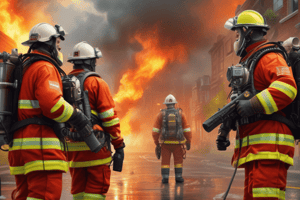Podcast
Questions and Answers
When should firefighter rehabilitation be implemented?
When should firefighter rehabilitation be implemented?
- Only during working fires
- Only during multi-alarm incidents
- Only during extended operations
- Any time the need is identified, such as working fires, multi-alarm incidents, extended operations, and training evolutions. (correct)
Who is responsible for ensuring a rehabilitation group is established when indicated?
Who is responsible for ensuring a rehabilitation group is established when indicated?
- The company officer
- The incident commander (correct)
- The rehabilitation officer
- The EMS member
How many levels of rehab are there?
How many levels of rehab are there?
- One
- Two
- Three (correct)
- Four
Who is responsible for all rehabilitation?
Who is responsible for all rehabilitation?
What must members do when instructed or assigned during rehabilitation?
What must members do when instructed or assigned during rehabilitation?
What is the responsibility of the training division regarding rehabilitation?
What is the responsibility of the training division regarding rehabilitation?
When can rehab resources be requested?
When can rehab resources be requested?
What must members do before entering the rehab area?
What must members do before entering the rehab area?
What vital signs are assessed by rehab members?
What vital signs are assessed by rehab members?
Who must release members before they resume operations?
Who must release members before they resume operations?
Flashcards are hidden until you start studying
Study Notes
- The document provides operational procedures for Chesapeake Fire Department firefighter rehabilitation.
- Rehabilitation should be implemented any time the need is identified, such as working fires, multi-alarm incidents, extended operations, and training evolutions.
- There are three levels of rehab, with formal rehab required for greater alarm incidents.
- The incident commander is responsible for ensuring a rehabilitation group is established when indicated, and the rehabilitation officer is responsible for all rehabilitation.
- The company officer must maintain awareness of the physical and mental conditions of each member operating within their span of control.
- Members must participate in rehabilitation services when instructed or assigned and maintain their hydration.
- The training division must develop and maintain an annual training program on rehabilitation for the department.
- The incident commander determines whether operational needs and weather conditions require establishing a formal rehabilitation group.
- The rehabilitation group should be positioned to its best advantage, with primary considerations including sufficient space, accessibility for EMS/medic units, and away from hazardous atmospheres.
- Rehab resources can be requested on all working incidents or when requested by the incident commander, and due to incident size, weather conditions, or geographic barriers, it may be necessary to establish more than one rehab group.
- EMS members assigned to rehab must provide medical screening and vital sign assessments.
- They must treat members exhibiting signs or symptoms requiring further assessment.
- Rehab officers are responsible for adjusting rest periods depending on work or environmental conditions.
- A record of all members passing through rehabilitation must be maintained.
- Members report to rehab after using two SCBA cylinders, 20 minutes of intense physical labor, SCBA failure, performing duties in hazardous materials encapsulating suits, or other times as needed.
- Members must undergo gross decontamination before entering the rehab area.
- Rehab members assess temperature, blood pressure, heart rate, respiratory rate, pulse oximetry, CO level, and skin condition.
- Members with a temperature greater than 101.6 F will rest for 20 minutes and then be re-evaluated.
- Members who do not meet evaluation benchmarks will be transferred to Medical Treatment and Transport.
- The Rehab Group Supervisor must release members before they resume operations.
Studying That Suits You
Use AI to generate personalized quizzes and flashcards to suit your learning preferences.




